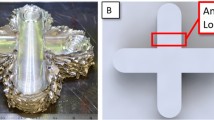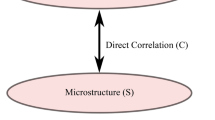Abstract
Aluminum alloys are widely used in transportation and aerospace industry because of their high strength-weight ratio and great formability. Compared with tuning grain refinement and solid solution, regulating precipitation strengthening through heat treatment is the most effective method to improve the yield strength of aluminum alloys. However, for the existing models, 3D precipitates are still simplified to 2D shape in aluminum alloys, and this trend causes the low accurate microstructure design. To address this issue, we develop a novel probability-dependent statistical model to predict the strength of aluminum alloys, considering the statistical distribution of the precipitate size and the relative spatial position of dislocations and precipitates. Compared with the classical model, the yield strength calculated from the current model is in good agreement with the experimental measurements, and the prediction accuracy is improved from 84.9% to 95.15%. In addition, the optimal size of precipitate is obtained for maximizing the strengthening effect. Our model not only provides a useful tool for the design of high-strength aluminum alloys, but also give a promising way to maximize the strength by changing the size distribution of the precipitate through a reasonable heat treatment process.















Similar content being viewed by others
References
Cazacu, O., Chandola, N., Revil-Baudard, B., Frodal, B.H., Børvik, T., Hopperstad, O.S.: Modeling the effect of notch geometry on the deformation of a strongly anisotropic aluminum alloy. Eur. J. Mech. A Solid 82, 104004 (2020)
Cheng, J., Lane, R., Kesler, M.S., Brechtl, J., Hu, X., Mirzaeifar, R., Nawaz, K.: Experiment and non-local crystal plasticity finite element study of nanoindentation on Al-8Ce-10Mg alloy. Int. J. Solid. Struct. 233, 111233 (2021)
Frodal, M., Børvik, H.: On the effect of plastic anisotropy, strength and work hardening on the tensile ductility of aluminium alloys. Int. J. Solid. Struct. 188, 118–132 (2020)
Morin, D., Fourmeau, M., Børvik, T., Benallal, A., Hopperstad, O.S.: Anisotropic tensile failure of metals by the strain localization theory: an application to a high-strength aluminium alloy. Eur. J. Mech. A Solid 69, 99–112 (2018)
Mulyukov, R.R., Korznikova, G.F., Nazarov, K.S., Khisamov, R.K., Sergeev, S.N., Shayachmetov, R.U., Korznikova, E.A.: Annealing-induced phase transformations and hardness evolution in Al–Cu–Al composites obtained by high-pressure torsion. Acta Mech. 232, 1815–1828 (2021)
Cao, D., Malakooti, S., Kulkarni, V.N., Ren, Y., Lu, H.: Nanoindentation measurement of core–skin interphase viscoelastic properties in a sandwich glass composite. Mech. Time-Depend. Mater. 25, 353–363 (2021)
Cao, D., Malakooti, S., Kulkarni, V.N., Ren, Y., Liu, Y., Nie, X., Lu, H.: The effect of resin uptake on the flexural properties of compression molded sandwich composites. Wind Energy 25, 71–93 (2022)
Wang, X., Xu, T., de Andrade, M.J., Rampalli, I., Cao, D., Haque, M., Lu, H.: The interfacial shear strength of carbon nanotube sheet modified carbon fiber composites. Chall. Mech. Time Depend. Mater. 2, 25–32 (2021)
Cusset, R., Azzouz, F., Besson, J., Dragon-Louiset, M., Jacques, V., Proudhon, H.: Modeling plasticity of an aluminum 2024T351 thick rolled plate for cold forming applications. Int. J. Solid. Struct. 202, 463–474 (2020)
Liu, H., Wang, X.M., Liang, H., Zhao, Z.N., Li, L., Yue, Z.F., Deng, C.H.: The effect of void defect on the evolution mechanisms of dislocations and mechanical properties in nickel-based superalloys by molecular dynamics simulation of real γ/γ′ structures. Int. J. Solid. Struct. 191, 464–472 (2020)
Xu, T., Arson, C.: Self-consistent approach for modeling coupled elastic and visco-plastic processes induced by dislocation and pressure solution. Int. J. Solid. Struct. 238, 111376 (2022)
Faleskog, J., Gudmundson, P.: Analytical predictions of yield stress of a strain gradient plasticity material reinforced by small elastic particles. J. Mech. Phys. Solids 157, 104623 (2021)
Sha, G., Cerezo, A.: Early-stage precipitation in Al–Zn–Mg–Cu alloy (7050). Acta Mater. 52, 4503–4516 (2004)
Fan, H., Zhu, Y., El-Awady, J.A., Raabe, D.: Precipitation hardening effects on extension twinning in magnesium alloys. Int. J. Plast. 106, 186–202 (2018)
Hu, Y., Curtin, W.A.: Modeling peak-aged precipitate strengthening in Al–Mg–Si alloys. J. Mech. Phys. Solids 151, 104378 (2021)
Hu, T., Ma, K., Topping, T.D., Schoenung, J.M., Lavernia, E.J.: Precipitation phenomena in an ultrafine-grained Al alloy. Acta Mater. 61, 2163–2178 (2013)
Li, L., Liu, F., Tan, L., Fang, Q.H., Liaw, P.K., Li, J.: Uncertainty and statistics of dislocation-precipitate interactions on creep resistance. Cell Rep. Phys. Sci. 3, 100704 (2022)
Deng, X.: Precipitation strengthening of stress-aged Al-Cu-Mg-Ag alloy single crystals. Mater. Sci. Eng. A 819, 141458 (2021)
Liu, H., Papadimitriou, I., Lin, F.X., LLorca, J.: Precipitation during high temperature aging of Al–Cu alloys: a multiscale analysis based on first principles calculations. Acta Mater. 167, 121–135 (2019)
Krasnikov, V.S., Mayer, A.E.: Dislocation dynamics in aluminum containing θ’phase: atomistic simulation and continuum modeling. Int. J. Plast. 119, 21–42 (2019)
Ren, S., Li, J., Fang, Q., Feng, H.: Effect of solid solution addition on the dislocation emission in aluminum alloys. Acta Mech. 231, 4537–4545 (2020)
Ma, K., Wen, H., Hu, T., Topping, T.D., Isheim, D., Seidman, D.N., Schoenung, J.M.: Mechanical behavior and strengthening mechanisms in ultrafine grain precipitation-strengthened aluminum alloy. Acta Mater. 62, 141–155 (2014)
Santos-Güemes, R., Segurado, J., LLorca, J.: A generalized line tension model for precipitate strengthening in metallic alloys. Eur. J. Mech. A Solid 93, 104540 (2022)
Lee, S.H., Jung, J.G., Baik, S.I., Seidman, D.N., Kim, M.S., Lee, Y.K., Euh, K.: Precipitation strengthening in naturally aged Al–Zn–Mg–Cu alloy. Mater. Sci. Eng. A 803, 140719 (2021)
Wen, H., Topping, T.D., Isheim, D., Seidman, D.N., Lavernia, E.J.: Strengthening mechanisms in a high-strength bulk nanostructured Cu–Zn–Al alloy processed via cryomilling and spark plasma sintering. Acta Mater. 61, 2769–2782 (2013)
Santos-Güemes, R., Bellón, B., Esteban-Manzanares, G., Segurado, J., Capolungo, L., LLorca, J.: Multiscale modelling of precipitation hardening in Al–Cu alloys: Dislocation dynamics simulations and experimental validation. Acta Mater. 188, 475–485 (2020)
Ma, K., Hu, T., Yang, H., Topping, T., Yousefiani, A., Lavernia, E.J., Schoenung, J.M.: Coupling of dislocations and precipitates: impact on the mechanical behavior of ultrafine grained Al–Zn–Mg alloys. Acta Mater. 103, 153–164 (2016)
Dai, P., Luo, X., Yang, Y., Kou, Z., Huang, B., Wang, C., Ru, J.: Nano-scale precipitate evolution and mechanical properties of 7085 aluminum alloy during thermal exposure. Mater. Sci. Eng. A 729, 411–422 (2018)
Bellón, B., Haouala, S., Lorca, J.: An analysis of the influence of the precipitate type on the mechanical behavior of Al-Cu alloys by means of micropillar compression tests. Acta Mater. 194, 207–223 (2020)
Ahmadi, M.R., Sonderegger, B., Povoden-Karadeniz, E., Falahati, A., Kozeschnik, E.: Precipitate strengthening of non-spherical precipitates extended in <100> or 100 direction in fcc crystals. Mater. Sci. Eng. A 590, 262–266 (2014)
Esteban-Manzanares, G., Bellón, B., Martínez, E., Papadimitriou, I., LLorca, J.: Strengthening of Al–Cu alloys by Guinier-Preston zones: predictions from atomistic simulations. J. Mech. Phys. Solids 132, 1036 (2019)
Chen, H., Chen, Z., Ji, G., Zhong, S., Wang, H., Borbély, A., Bréchet, Y.: The influence of shearable and nonshearable precipitates on the Portevin-Le Chatelier behavior in precipitation hardening AlMgScZr alloys. Int. J. Plast. 147, 103120 (2021)
Luca, A.D., Seidman, D.N., Dunand, D.C.: Effects of Mo and Mn microadditions on strengthening and over-aging resistance of nanoprecipitation-strengthened Al-Zr-Sc-Er-Si alloys. Acta Mater. 165, 1–14 (2019)
Nie, J.F., Muddle, B.C.: Microstructural design of high-strength aluminum alloys. J. Phase Equilib. 19, 543–551 (1998)
Xue, H., Yang, C., Kuang, J., Zhang, P., Zhang, J.Y., Liu, G., Sun, J.: Highly interdependent dual precipitation and its effect on mechanical properties of Al–Cu-Sc alloys. Mater. Sci. Eng. A 820, 141526 (2021)
Fang, Q., Li, L., Li, J., Wu, H., Huang, Z., Liu, B., Liaw, P.K.: A statistical theory of probability-dependent precipitation strengthening in metals and alloys. J. Mech. Phys. Solids 122, 177–189 (2019)
Yang, Y., He, G., Liu, Y., Li, K., Wu, W., Huang, C.: Quantitative contribution of T1 phase to the strength of Al-Cu-Li alloys. J. Mater. Sci. 56, 18368–18390 (2021)
Krasnikov, V.S., Mayer, A.E., Pogorelko, V.V., Latypov, F.T., Ebel, A.A.: Interaction of dislocation with GP zones or θ" phase precipitates in aluminum: Atomistic simulations and dislocation dynamics. Int. J. Plast. 125, 169–190 (2020)
Alabbad, B., Li, L., Tin, S.: Controlling the grain boundary morphology and secondary γ′ precipitate size distribution in Ni-base superalloys. J. Alloys Compd. 775, 931–941 (2019)
Yildiz, R.A., Yilmaz, S.: Experimental Investigation of GTN model parameters of 6061 Al alloy. Eur. J. Mech. A Solid 83, 104040 (2020)
Chen, Z., Zhao, K., Fan, L.: Combinative hardening effects of precipitation in a commercial aged Al–Cu–Li–X alloy. Mater. Sci. Eng. A 588, 59–64 (2013)
Jiang, B., Wang, H., Yi, D., Tian, Y., Shen, F., Wang, B., Hu, Z.: Effect of Ag addition on the age hardening and precipitation behavior in an Al-Cu-Li-Mg-Zn-Mn-Zr alloy. Mater. Charact. 162, 110184 (2020)
Chung, T.F., Yang, Y.L., Shiojiri, M., Hsiao, C.N., Li, W.C., Tsao, C.S., Yang, J.R.: An atomic scale structural investigation of nanometre-sized η precipitates in the 7050 aluminium alloy. Acta Mater. 174, 351–368 (2019)
Peng, J., Li, L., Li, F., Liu, B., Zherebtsov, S., Fang, Q., Li, J., Stepanov, N., Liu, Y.: The predicted rate-dependent deformation behaviour and multistage strain hardening in a model heterostructured body-centered cubic high entropy alloy. Int. J. Plast. 145, 103073 (2021)
Yuan, R.: Establishing a quantitative relationship between strain gradient and hetero-deformation-induced stress in gradient-structured metals. Acta Mech. 233, 961–989 (2022)
Chen, J., Lv, L., Zhen, L., Dai, S.: Precipitation strengthening model of AA7055 aluminium alloy. Acta Metall. Sin. 57, 353–362 (2020)
Seidman, D.N., Marquis, E.A., Dunand, D.C.: Precipitation strengthening at ambient and elevated temperatures of heat-treatable Al(Sc) alloys. Acta Mater. 50, 4021–4035 (2002)
Souza, P.H.L., de Oliveira, C.A.S., Quaresma, J.M.V.: Precipitation hardening in dilute Al–Zr alloys. J. Mater. Res. Technol. 7, 66–72 (2018)
Wang, Y., Zhang, S., Wu, R., Turakhodjaev, N., Hou, L., Zhang, J., Betsofen, S.: Coarsening kinetics and strengthening mechanisms of core-shell nanoscale precipitates in Al-Li-Yb-Er-Sc-Zr alloy. J. Mater. Sci. Technol. 61, 197–203 (2021)
Semiatin, S.L., Mahaffey, D.W., Levkulich, N.C., Senkov, O.N., Tiley, J.S.: The effect of cooling rate on high-temperature precipitation in a powder-metallurgy, gamma/gamma-prime nickel-base superalloy. Metall. Mater. Trans A 49, 6265–6276 (2018)
Fang, Q., Huang, Z., Li, L., Huang, Z., Liu, B., Liu, Y., Liaw, P.K.: Modeling the competition between solid solution and precipitate strengthening of alloys in a 3D space. Int. J. Plast. 149, 103152 (2022)
Li, Y., Shi, Z., Lin, J., Yang, Y.L., Rong, Q., Huang, B.M., Balint, D.S.: A unified constitutive model for asymmetric tension and compression creep-ageing behaviour of naturally aged Al-Cu-Li alloy. Int. J. Plast. 89, 130–149 (2017)
Acknowledgments
The authors would like to deeply appreciate the supports from National Natural Science Foundation of China (U2267252, 12172123, and 12072109), Natural Science Foundation of Hunan Province (2022JJ20001 and 2021JJ40032), and the science and technology innovation Program of Hunan Province (2022RC1200).
Author information
Authors and Affiliations
Corresponding authors
Ethics declarations
Conflict of interest
The authors declare that they have no known competing financial interests or personal relationships that could have appeared to influence the work reported in this paper.
Additional information
Publisher's Note
Springer Nature remains neutral with regard to jurisdictional claims in published maps and institutional affiliations.
Rights and permissions
Springer Nature or its licensor (e.g. a society or other partner) holds exclusive rights to this article under a publishing agreement with the author(s) or other rightsholder(s); author self-archiving of the accepted manuscript version of this article is solely governed by the terms of such publishing agreement and applicable law.
About this article
Cite this article
Wang, S., Li, L., Chen, G. et al. Modeling the effect of precipitation spatial geometry and size distribution on the yield strength of aluminum alloys. Acta Mech 234, 4323–4342 (2023). https://doi.org/10.1007/s00707-023-03608-0
Received:
Revised:
Accepted:
Published:
Issue Date:
DOI: https://doi.org/10.1007/s00707-023-03608-0




